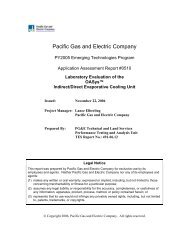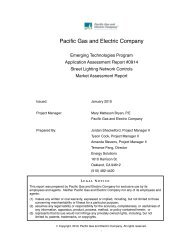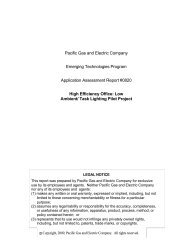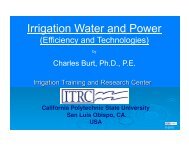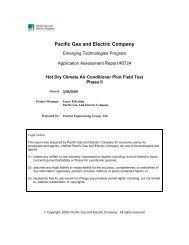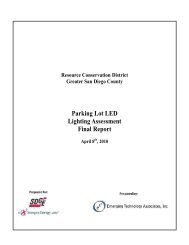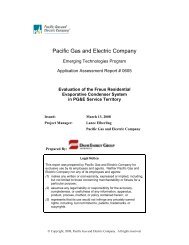Download the project report.
Download the project report.
Download the project report.
Create successful ePaper yourself
Turn your PDF publications into a flip-book with our unique Google optimized e-Paper software.
Figure 3: ATS Water Heater Laboratory (Six Test Stands)<br />
The conditions of <strong>the</strong> standard Energy Factor test also influenced <strong>the</strong> test apparatus. The standard Energy<br />
Factor test requires a water supply temperature of 58°F, which means a method of tempering <strong>the</strong> supply<br />
water to maintain that temperature was needed. Since <strong>the</strong> water draws are a short-term event process<br />
ra<strong>the</strong>r than continuous, <strong>the</strong> test apparatus was designed with a storage tank that was normally maintained<br />
with a supply of chilled water by an external chiller. Before entering <strong>the</strong> supply header to <strong>the</strong> test units,<br />
<strong>the</strong> water passes through a 3-way valve to mix tap water with chilled water to achieve <strong>the</strong> desired supply<br />
temperature.<br />
The outlet from each test water heater is controlled by a solenoid valve, and fed into a common outlet<br />
header. This header passes through a high-accuracy Coriolis mass flow meter for hot water discharge<br />
flow ra<strong>the</strong>r than a weigh tank. The flow rate is controlled by an array of four flow control valves in<br />
parallel, with each set to a different flow rate and activated by solenoid valves at <strong>the</strong>ir outlets. The DOE<br />
standard flow rate for <strong>the</strong> Energy Factor, First Hour Rating, and Recovery Efficiency is 3 gallons per<br />
minute (gpm), so one of <strong>the</strong> valves was set to this flow rate.<br />
Measurements and Instrumentation<br />
The measurements are mostly those required by <strong>the</strong> DOE test standard, and includes those necessary to<br />
measure <strong>the</strong> energy removed in a hot water draw (flow and temperatures in and out of <strong>the</strong> tank), <strong>the</strong><br />
energy consumed by <strong>the</strong> water heater (electric energy input to <strong>the</strong> heat pump and/or electric resistance<br />
elements), <strong>the</strong> change in stored energy in <strong>the</strong> tank (tank temperatures), and <strong>the</strong> ambient conditions (air<br />
temperature, humidity, and pressure). Additional measurements were needed for <strong>the</strong> feedback control<br />
system. The complete list of measurements and <strong>the</strong> instruments used for <strong>the</strong>m is shown in Table 7 in <strong>the</strong><br />
Appendix.<br />
Prior to testing, all of <strong>the</strong> RTD temperature probes were calibrated against a laboratory standard<br />
temperature sensor in an ice bath (32°F), a gallium melting point cell (85.6°F), and in a flask of hot water<br />
(~120°F). Pressure sensors were calibrated against a portable pneumatic calibrator.<br />
Data Acquisition System<br />
The instrumentation was connected to multiple rack-mounted Compact FieldPoint modules from National<br />
Instruments, depending on <strong>the</strong> signal type. The signal conditioning modules included different units for<br />
RTDs, <strong>the</strong>rmocouples, voltage and pulse count (water and gas meters) inputs, plus both analog and digital<br />
491-09.17.doc 10



